*NURSING > QUESTION PAPER & MARK SCHEME > NBCOT Practice Exam 1 All Questions and Answers. With Rationales Graded A+ (All)
NBCOT Practice Exam 1 All Questions and Answers. With Rationales Graded A+
Document Content and Description Below
An OT is preparing to evaluate a toddler who has upper extremity orthopedic concerns. How will the OT MOST likely obtain the majority of initial assessment data? A. Measurement tools that assess vi ... sual-motor skills B. Dynamometer and pinch meter readings. C. Observation of child during activities in the child-care center. D. Functional independence measures. - Ans-C. Observation of child during activities in the child-care center. Through observation of the child during child-care center activities, the OT can collect information about the child's motor performance skills and participation in activities that require upper extremity/hand skill. Naturalistic observation is a method of ecological assessment, which is "a primary mechanism for obtaining data relevant to the child's performance context..... Skilled observation of child performing a functional task offers..... important information about the child's performance". Answers A, B, ad D are all appropriate choices after the child is old enough for these assessments. During an initial evaluation, the OT suspects that a child has somatodyspraxia. In what area should the OT focus the evaluation? A. Ability to print or write. B. Reading competency. C. Math calculations. D. New motor task planning. - Ans-D. New motor task planning. "Somatodyspraxia is described as a deficit in learning new motor skills, planning new motor actions, and generalizing motor plans." Inability to print or write (answer A) is termed "dysgraphia." The term "dyslexia" (answer B) means dysfunction in reading. Inability to perform mathematics (answer C) is known as "dyscalculia" An OT working in a long-term care facility needs to evaluate the long-term memory of a resident. Which of the following methods is BEST for evaluating memory or personally experienced events (declarative memory)? A. Show the person a series of objects and ask him to recall the objects within 60 seconds. B. Ask the individual how he spent New Year's/ C. Have the individual state the place, date, and time. D. Ask the client to remember to bring a specific item to the next therapy session - Ans-B Ask the individual how he spent New Year's "Declarative memory is one aspect of long term memory and includes conscious memory for events, knowledge or facts". It is commonly assessed through verbal interviews and informal testing such as asking a question about an individual's recall of personal events (answer B). Working memory refers to "the temporary storage of inforamtion while one is working with it or attending to it" (answer A). "Prospective memory involves the ability to remember intentions or activities that will be required in the future" (answer D). Knowing the date, place, and time is indicative of orientation (answer C). A child avoids playground equipment that requires her feet to be off the ground. What does this behavior MOST likely indicate? A. Difficulty modulating proprioception. B. Somatodyspraxia C. Gravitational insecurity D. Bilateral integration/sequencing deficit. - Ans-C. Gravitational insecurity. Gravitational insecurity is described as "fear response to movement". The child easily experiences a fear of falling and prefers to keep her feet firmly on the ground. Tactile defensiveness (answer A) is a term used to describe discomfort with various textures and with unexpected touch. Somatodyspraxia (answer B) has is "foundation in somatosensory (e.g. primarily tactile but also proprioceptive) discrimination deficits, which interfere with the development of body scheme and awareness". Bilateral integration and sequencing deficits are related to "poor vestibular-propioceptive discrimination, which interferes with the ability to coordinate, sequence, and execute motor actions quickly and efficiently". When the OT suspects tactile defensiveness as a rationale for a child's challenges, in what area of participation should the OT focus on FIRST? A. Play behavior B. Dressing habits C. Social skills D. Leisure interests - Ans-B. Dressing habits Children with tactile defensiveness are "bothered by tactile aspects of daily living activities.... specific types of clothing.... specific textures materials". The child may be bothered by certain textures or avoid wearing turtlenecks, socks, or shoes. Conversely, some children may never take off their shoes to avoid tactile stimulation. Play behavior (answer A), social skills (answer C), and the choice of hobbies (answer D) could be affected secondarily, as a result of intolerance to certain textures or human touch. Knowledge of the child's dressing habits will give the OT key information at the start of the evaluation process. An OT is working with an individual with schizophrenia who is in the process of preparing to move from a state hospital to a group home. During a baking group, the client becomes agitated and leaves the room when another client uses the electric hand mixer to mix the cake batter, and again when two clients begin to argue loudly about which type of icing to use. How would the OT BEST describe the behavior? A. Low registration B. Sensory avoiding C. Sensation seeking D. A hearing impairment - Ans-B. Sensory avoiding The individual's actions are indicative of sensor avoiding behavior, characterized by a low threshold to stimuli perceived as noxious, followed by an active response such as leaving the room. Individuals with sensory avoiding behavior may "become distressed in situations in which they cannot control the environment" and "do well in low stimulus situation or settings that others find dull". An individual with low registration (answer A), sensory seeking behavior (answer C), or a hearing impairment (answer D) would not have difficult with the auditory stimulation caused by the roar of the mixer or loud voices. During a self-care evaluation of an individual who recently sustained a brain injury, the OT instructs the individual to comb his hair immediately after he washes his face. The individual washes his face quickly, but then the therapist must give him several reminders to comb his hair. The OT is MOST likely to identify this as a deficit in what area? A. Working memory B. Judgment C. Hearing D. Abstraction - Ans-A. Working memory "Working memory is the temporary storage of information while one is working with it or attending to it. It includes the ability to recall information immediately after exposure. It allows one to focus conscious attention and keeps track of information as one is performing an activity". This individual's inability to comb is hair without reminders suggests a deficit in working memory (answer A). Judgment (answer B), the ability to make realistic and safe decisions based on available environmental information, would not be needed for this task. Because the person performed the first request, hearing (answer C) would seem to be intact. Abstraction (answer D) is the ability to extrapolate information from an idea to generalize to another situation and would not be needed to follow this direction. A supermarket employee with obsessive-compulsive disorder takes an hour to stock 24 soup cans on the shelf because once he has placed the cans on the shelf, he removes them and starts over, stating that "all labels were not lines up exactly in the same direction." Which of the following methods would MOST effectively evaluate the individual's work performance? A. On-site observation of performance skills B. Formal cognitive assessment C. Verbal interview focusing on the requirements of the job D. Task evaluation using a "clean" medium such as a puzzle - Ans-A. On-site observation of performance skills An OT has been working with an individual who is recovering from a TBI. A standard pivot transfer has been successfully demonstrated in the gym. The MOST appropriate way to assess generalization of this new learning would be to have the patient perform which activity? A. Identify potential hazards in the patient's bathrooms that could make transfers unsafe B. Select an appropriate tub bench and nonskid mat for the patient's bathroom at home C. Attempt a standard pivot transfer from wheelchair to bed in the patient's hospital room D. Attempt a sliding board transfer from wheelchair to tub - Ans-C. Attempt a standard pivot transfer from wheelchair to bed in the patient's hospital room An OT is working with an individual with depression who is cognitively intact but demonstrating difficulty carrying out self-care and other ADL tasks. The OT, who has no advanced certifications, would like to identify a standardized assessment to measure ADL performance. Which is the MOST appropriate tool for this purpose? A. Bay Area Functional Performance Evaluation B. Routine Task Inventory-Expanded C. Kohlman Evaluation of Living Skills D. Assessment of Motor and Process Skills - Ans-C. Kohlman Evaluation of Living Skills An OT is conducting a perceptual function screening with an individual who has had a CVA. Which of the following informal screening activities would the therapist ask the individual to perform in order to identify the presence of agnosia? A. Demonstrate common gestures such as waving B. Name objects through touch only C. Identify or demonstrate the use of common household objects D. Read a paragraph and explain its meaning. - Ans-C. Identify or demonstrate the use of common household objects An individual with an L4 spinal cord injury wishes to become independent in driving an automobile. The MOST appropriate piece of adaptive equipment for this individual is: A. A palmar cuff for the steering wheel B. A spinner knob on the steering wheel C. Pedal extensions for accelerating and braking D. Hand controls for acceleration and braking - Ans-D. Hand controls for acceleration and braking What is the MOST important aspect of administering and scoring a standardized test? A. Judgment to determine how best to administer the test B. Previous experience as a way to gauge test results C. Adherence to specific instructions for administration and scoring D. Practice administering the test items - Ans-C. Adherence to specific instructions for administration and scoring During an initial interview, parents describe their child as having difficulty communicating and interacting with others. The OT observes him repeatedly gazing upward and scanning the ceiling or quickly patting his hip. The behaviors described are MOST likely to be associated with what disorder? A. Attention deficit-hyperacitivity B. Childhood conduct C. Obsessive-compulsive D. Autism spectrum disorder - Ans-D. Autism spectrum disorder A toddler with spina bifida has been referred for assessment. When collecting the initial data during interview with the child's parent, what should the OT focus on PRIMARILY? A. A parent's concerns and goals for the child B. Child's medical management C. Equipment needs D. Physical layout of the home - Ans-A. A parent's concerns and goals for the child When evaluating an individual with coronary artery disease for controllable risk factors, what is MOST important for the OT to include as part of the assessment? A. Determine the individual's age and gender B. Assess the individual's lifestyle and dietary habits C. Observe the individual for obesity and cholesterol levels D. Determine whether the individual has a family history of heart disease - Ans-B. Assess the individual's lifestyle and dietary habits The OT has been working with an individual with deficits in the area of executive functioning postsurgery. When the OT asks about scheduling therapy appointments after discharge and transportation to the outpatient clinic, the client is unable to identify how to obtain the clinic's phone number or where to park. When the OT points out these missing areas, the client appears perplexed, then laughs it off, stating that someone else would be calling to schedule appointments and providing transportation. Attempting to subtly hint about cognitive deficits is no longer working, and the OT is concerned because despite repeated efforts the individual is not retaining safety precautions. This patient's behavior indicates a problem in what area? A. Denial B. Self-awareness C. Emotional regulation D. Sequencing - Ans-B. Self-awareness An OT is evaluating two-point discrimination in an individual with median nerve injury. What is the BEST way to administer this test? A. Apply the stimuli beginning at the little finger and progress toward the thumb B. Start with the thumb area first, then progress toward the little finger C. Present stimuli in an organized pattern to improve reliability during retesting D. Allow the individual unlimited time to respond - Ans-A. Apply the stimuli beginning at the little finger and progress toward the thumb An OT is initiating an evaluation of a pre-school child diagnosed with autism spectrum disorder. What is the OT MOST likely to include in the evaluation process? A. One-to-one interview with the child B. Observation of the child in a social, gross motor, and self-feeding task C. The Peabody Developmental Motor Scales-2 D. Assessment of the child's performance skills while outside on the playground - Ans-B. Observation of the child in a social, gross motor, and self-feeding task A high school teacher diagnosed with a right-hemisphere CVA is given a paper with letters of the alphabet displayed in random order across the page and is instructed to cross out every "M." The individual misses half of the "M"s in a random pattern. What type of deficit would cause such a response? A. A left visual field cut B. A right visual field cut C. Functional illiteracy D. Decreased attention - Ans-D. Decreased attention A college student with a history of substance abuse has been admitted to the hospital following an accidental overdose at a party. He states his goal is to return to school as soon as possible so that his GPA does not drop below 3.0. What is the MOST important area for the OT evaluation to focus on? A. Leisure skills B. Activities of daily living C. Academic/study skills D. Family education - Ans-A. Leisure skills What are the MOST important items to assess when evaluating motor control after a traumatic injury? A. Developmental factors and primitive reflexes B. Muscle tone, postural tone, reflexes, and coordination C. Blood pressure, heart rate, endurance, and confusion D. Self-concept and self- awareness - Ans-B. Muscle tone, postural tone, reflexes, and coordination A new parent recently returned to work and reports difficulty concentrating at work because of thoughts about the baby. When at home, the individual feels distracted by thoughts about work. This MOST likely suggests the need to help this individual in what area? [Show More]
Last updated: 3 years ago
Preview 1 out of 43 pages
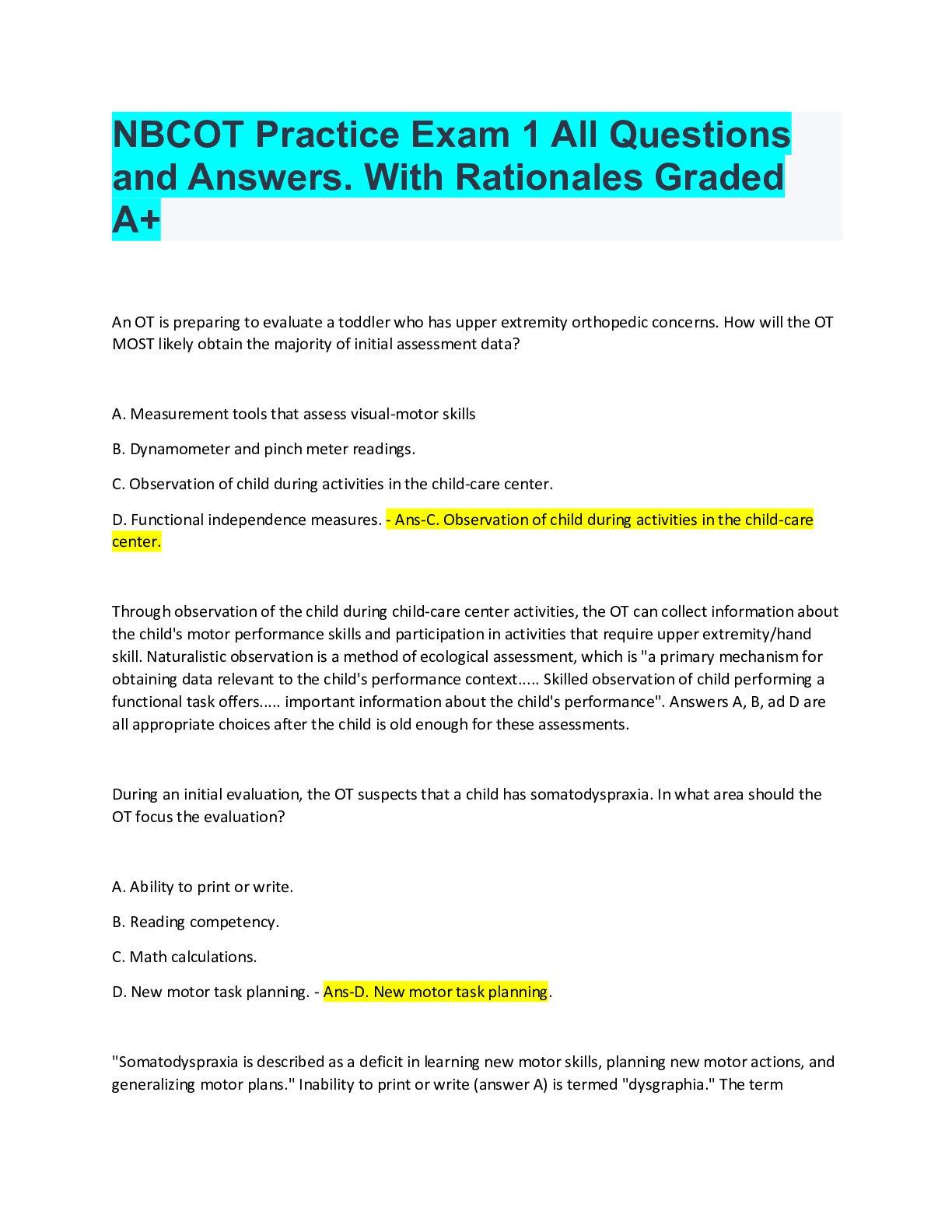
Buy this document to get the full access instantly
Instant Download Access after purchase
Buy NowInstant download
We Accept:

Reviews( 0 )
$10.00
Can't find what you want? Try our AI powered Search
Document information
Connected school, study & course
About the document
Uploaded On
Jun 10, 2022
Number of pages
43
Written in
All
Seller

Reviews Received
Additional information
This document has been written for:
Uploaded
Jun 10, 2022
Downloads
0
Views
118
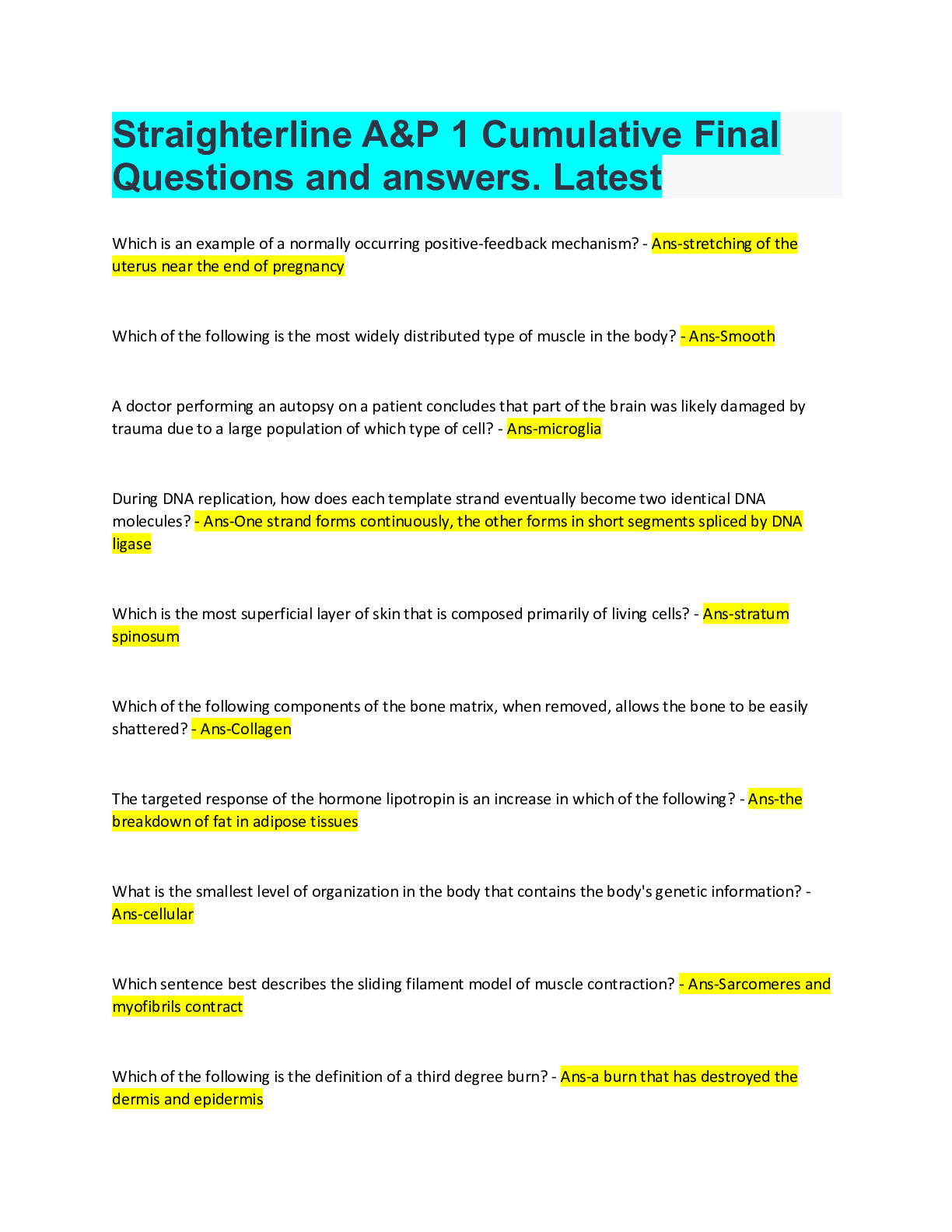
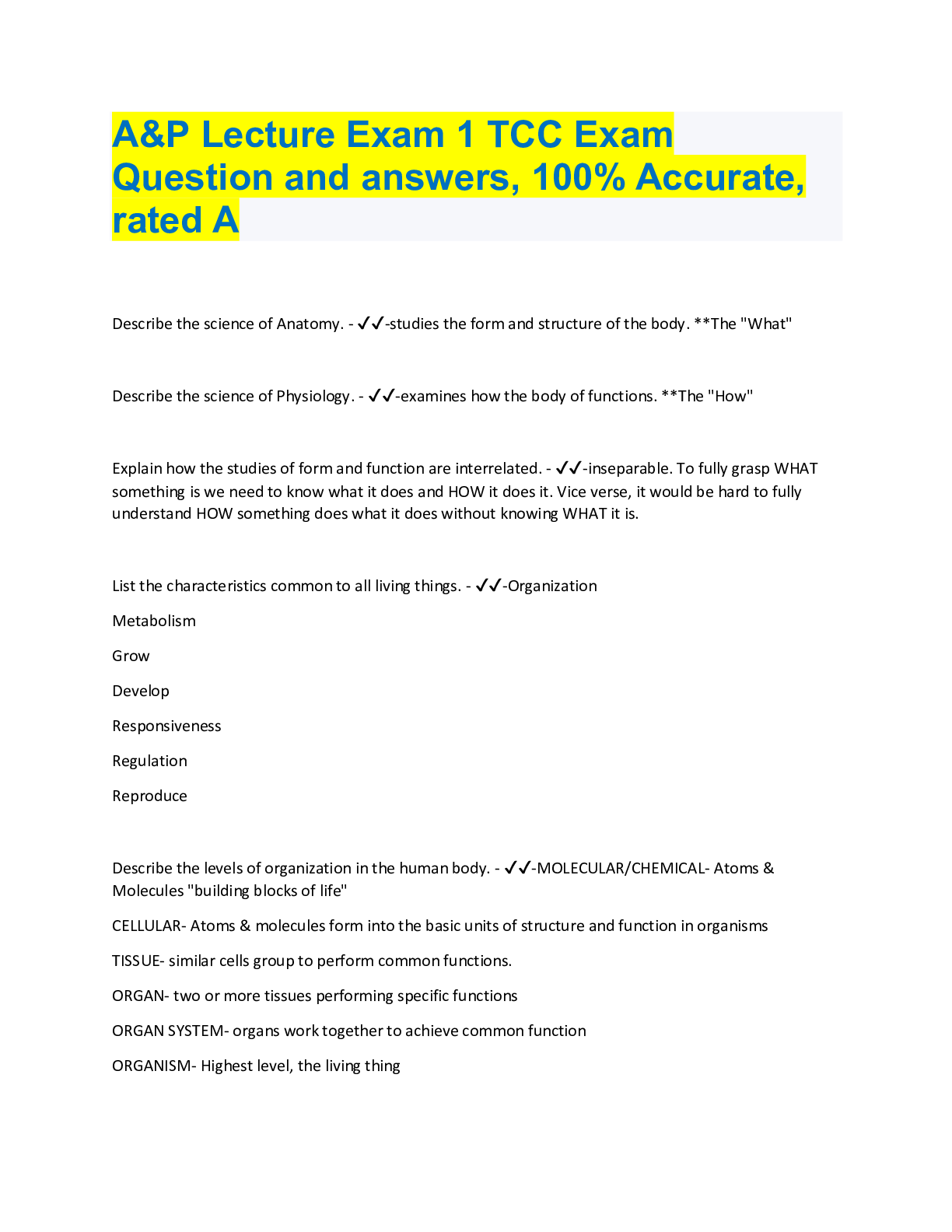
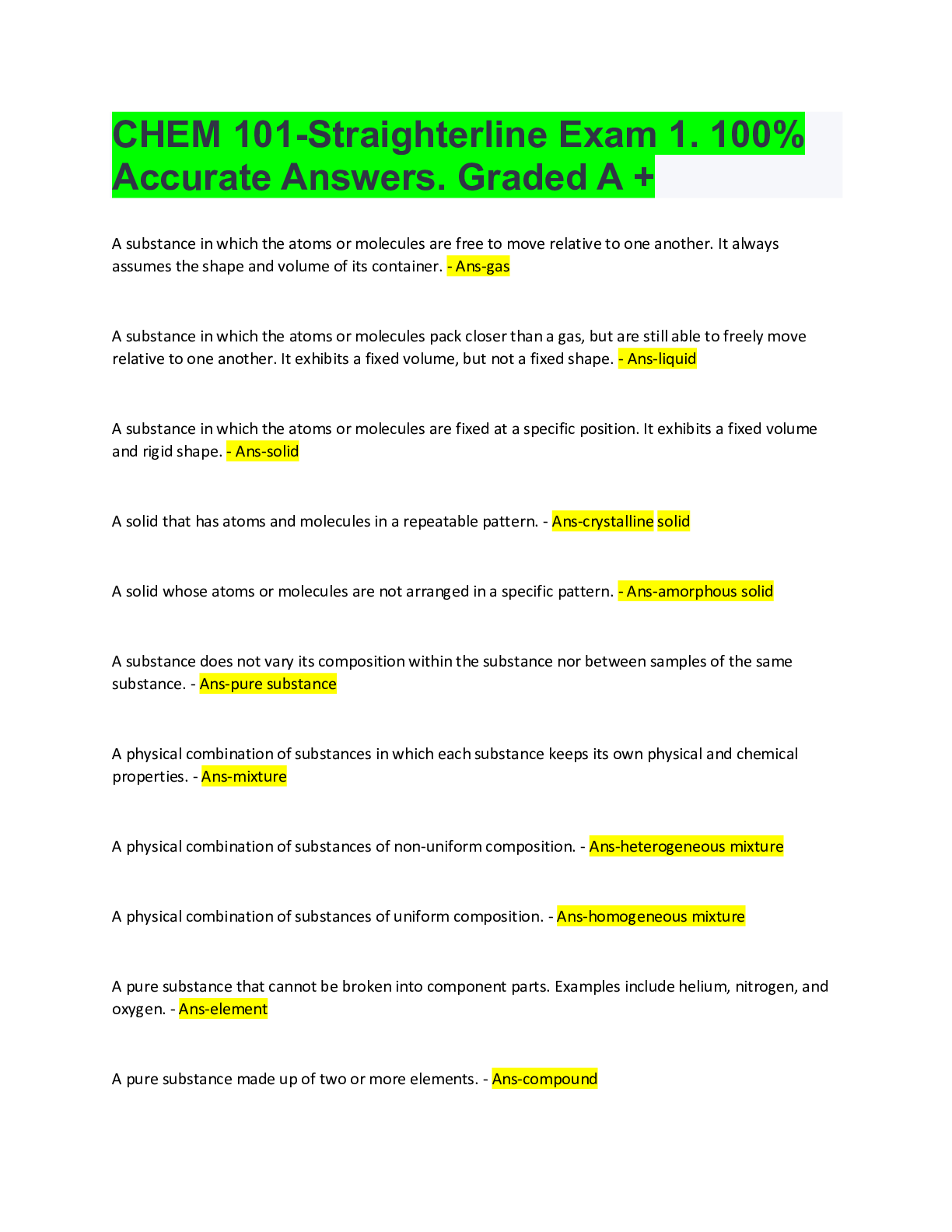


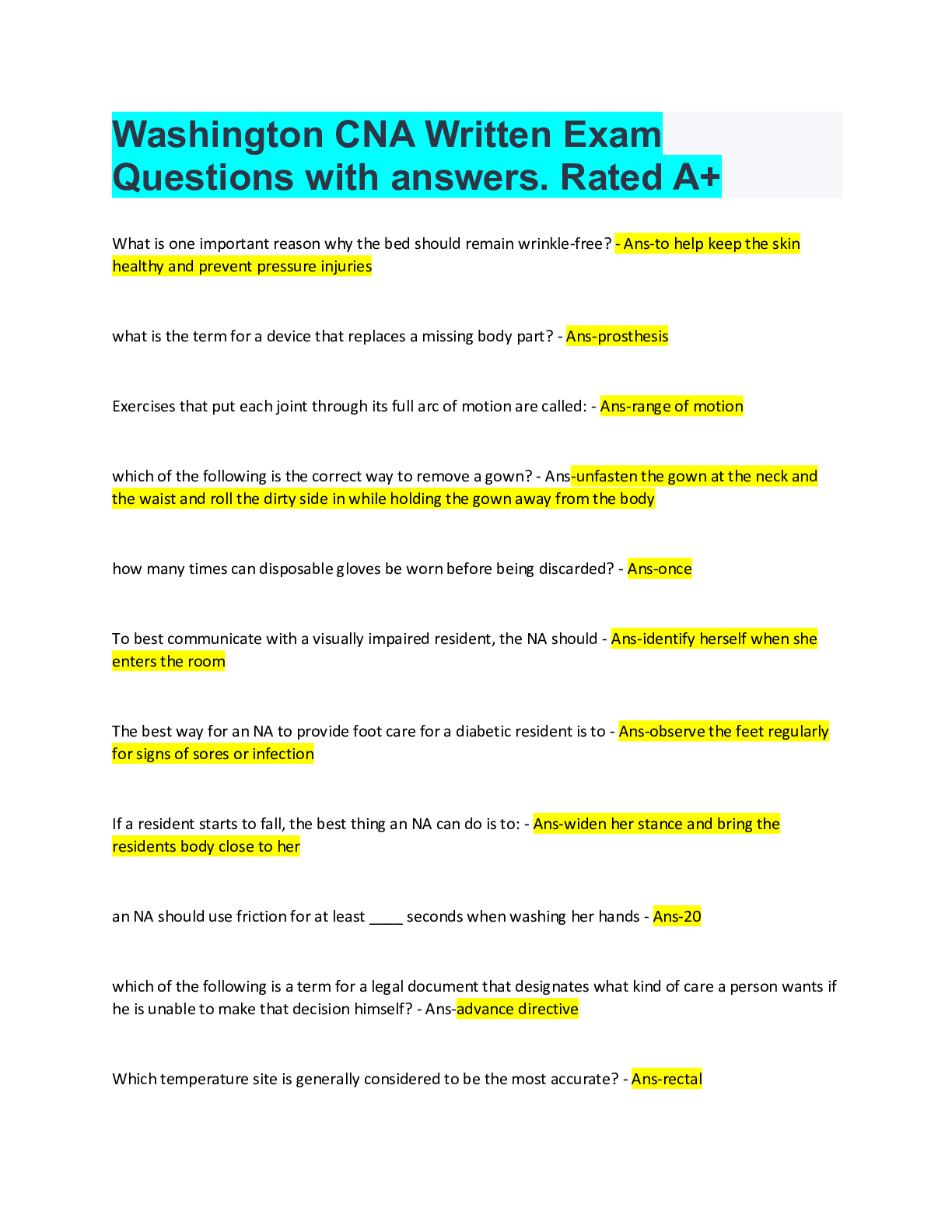
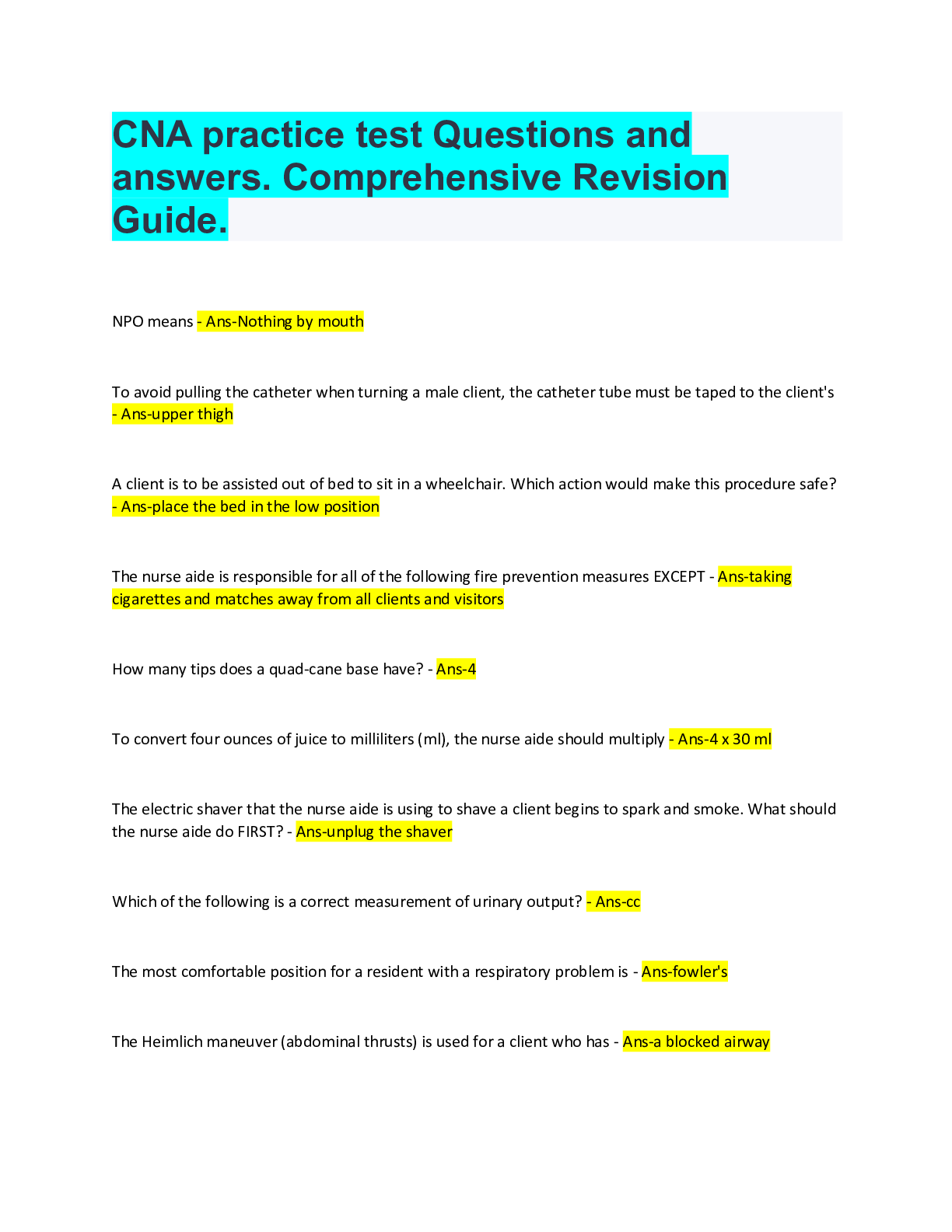

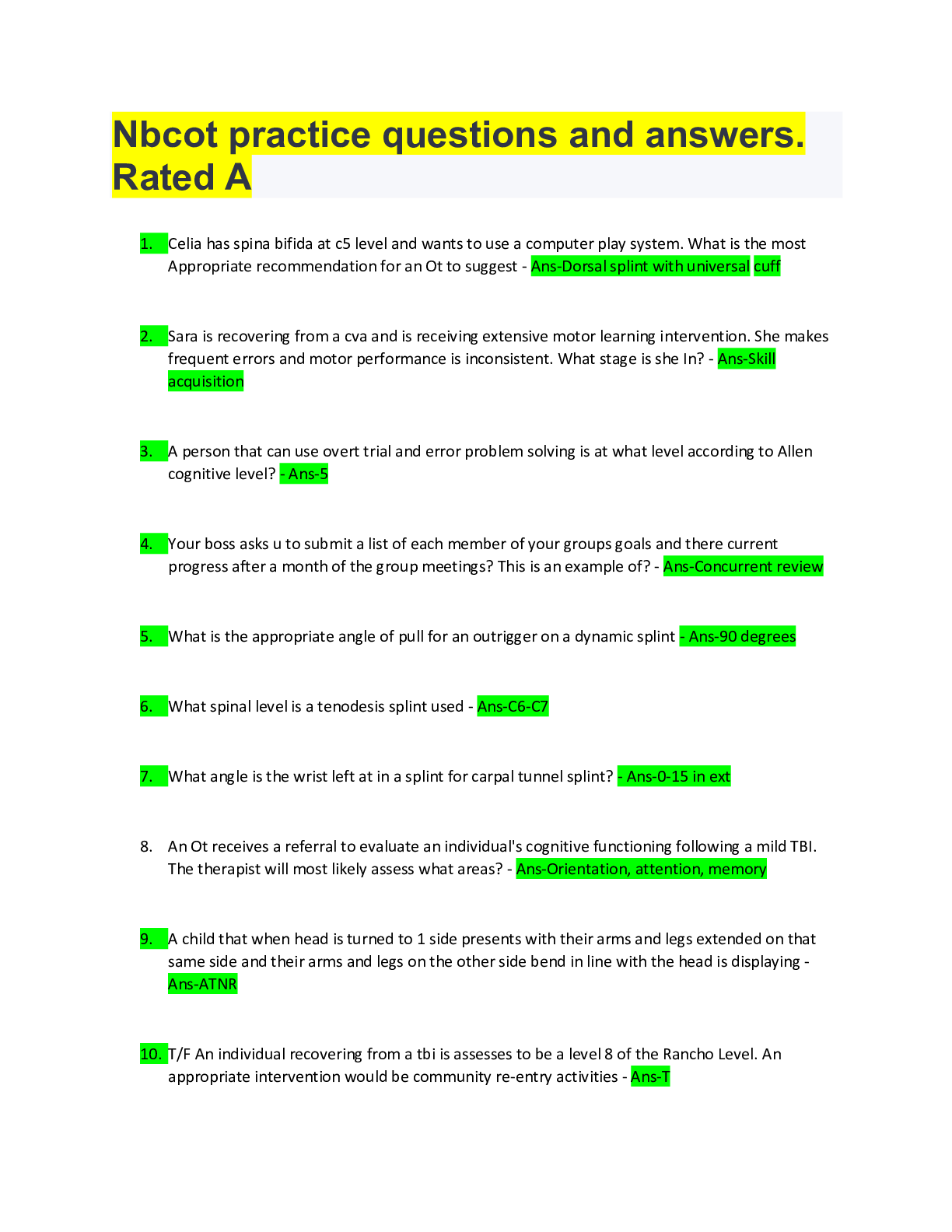
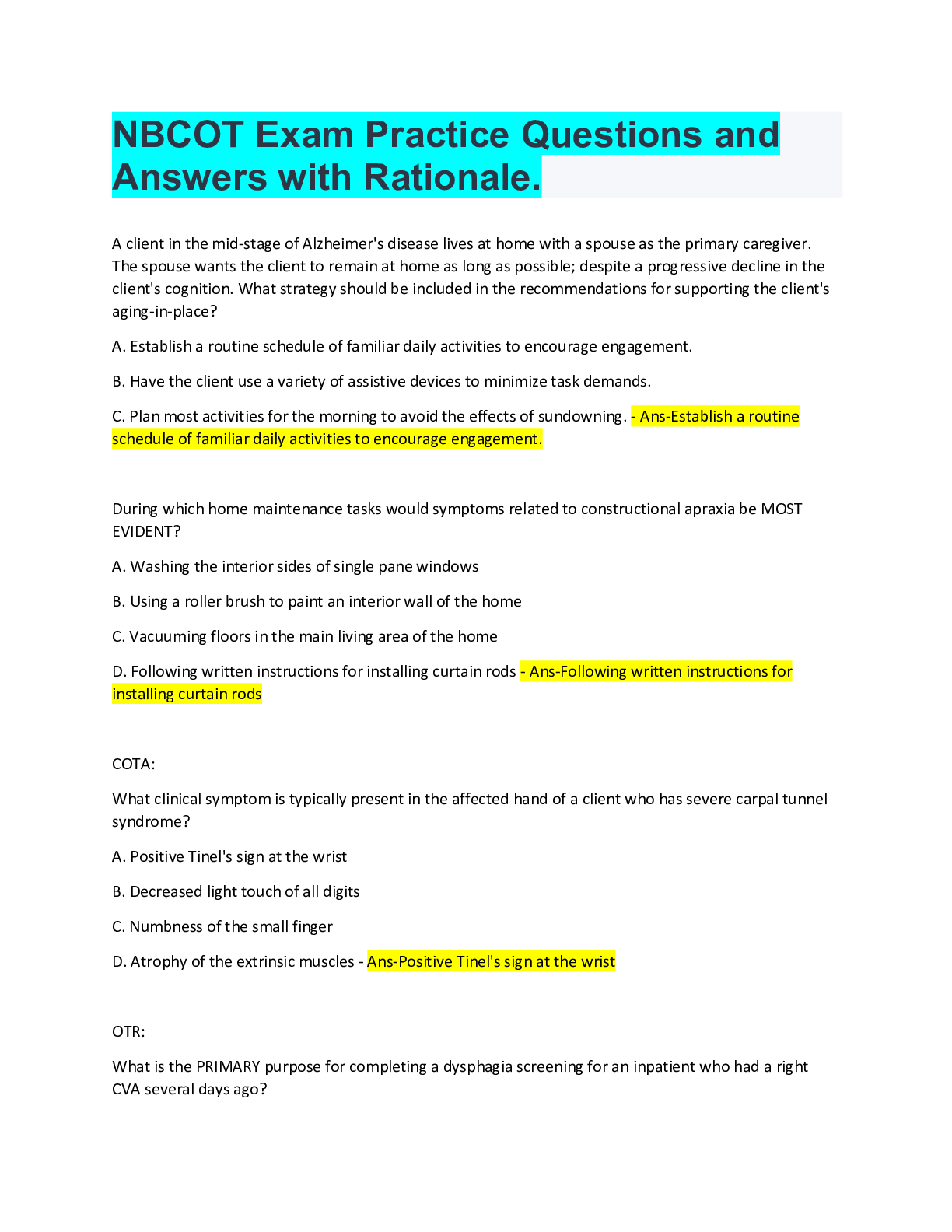
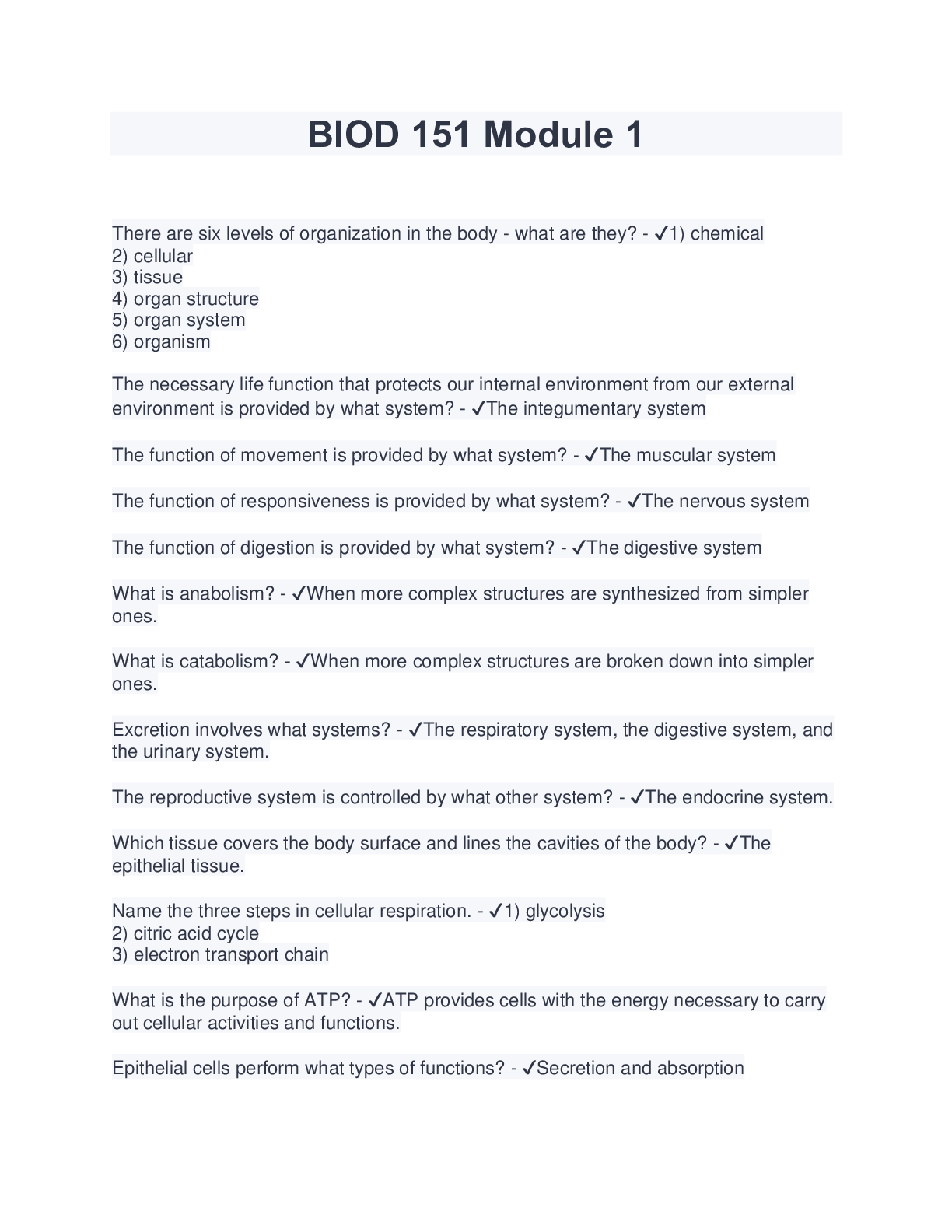
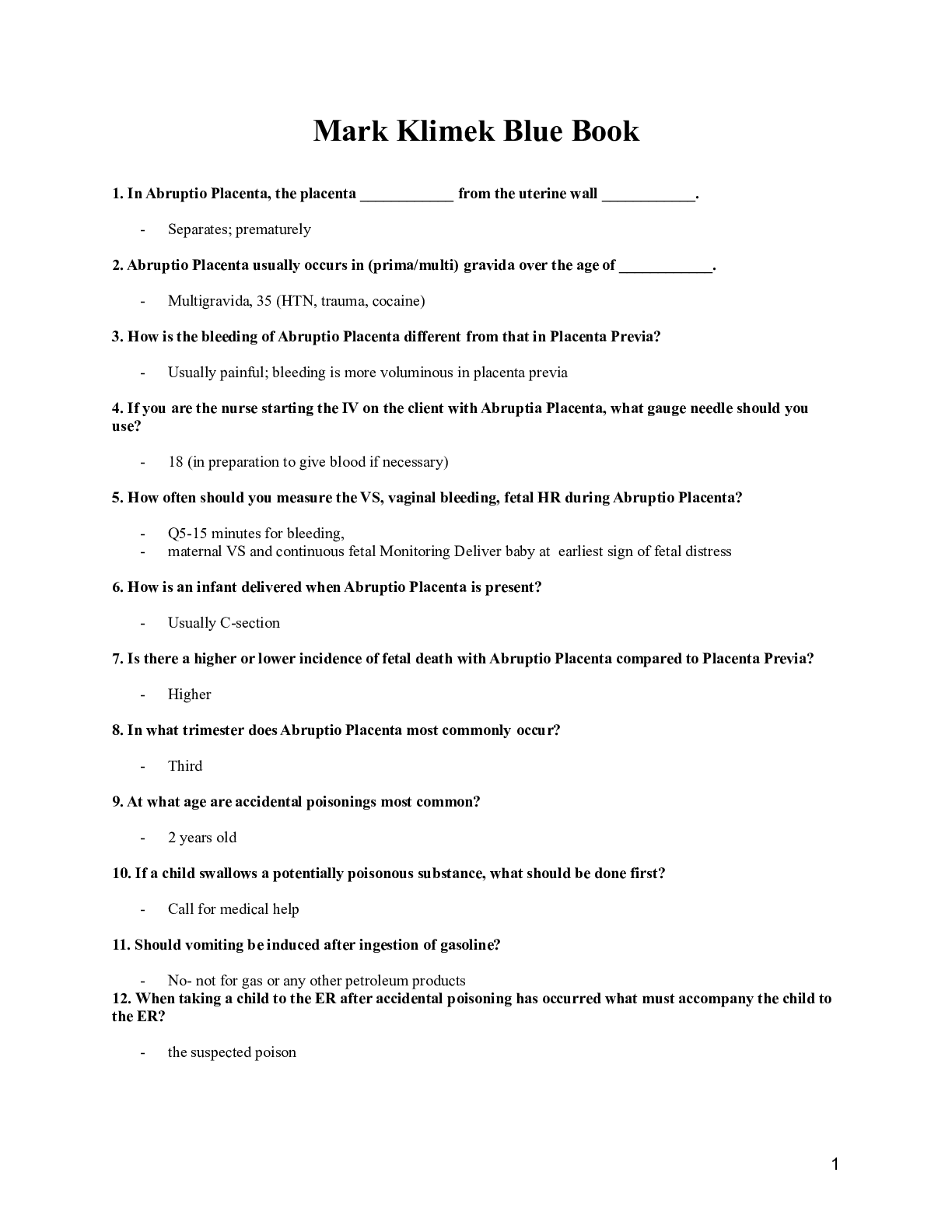
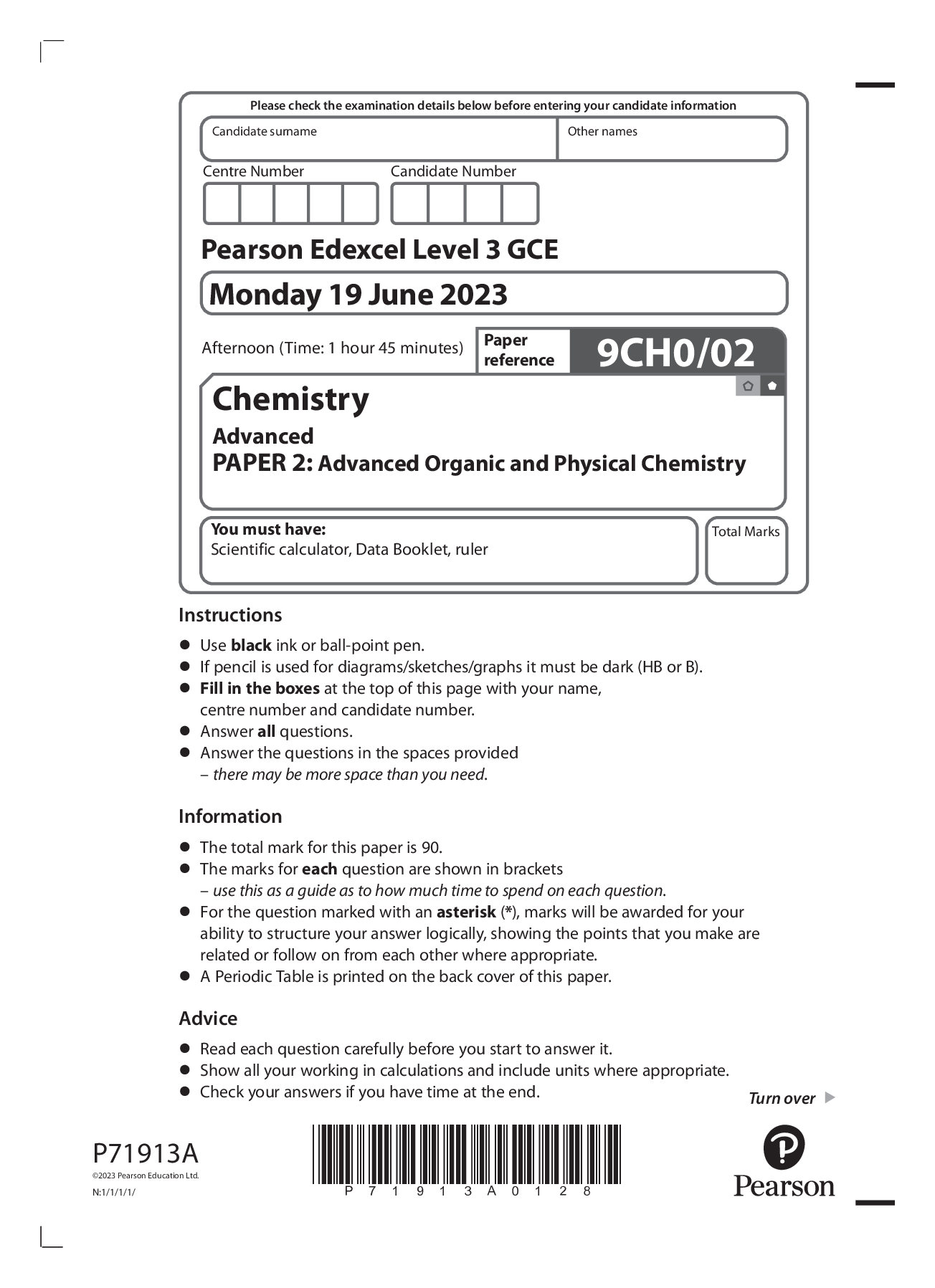




.png)
.png)

